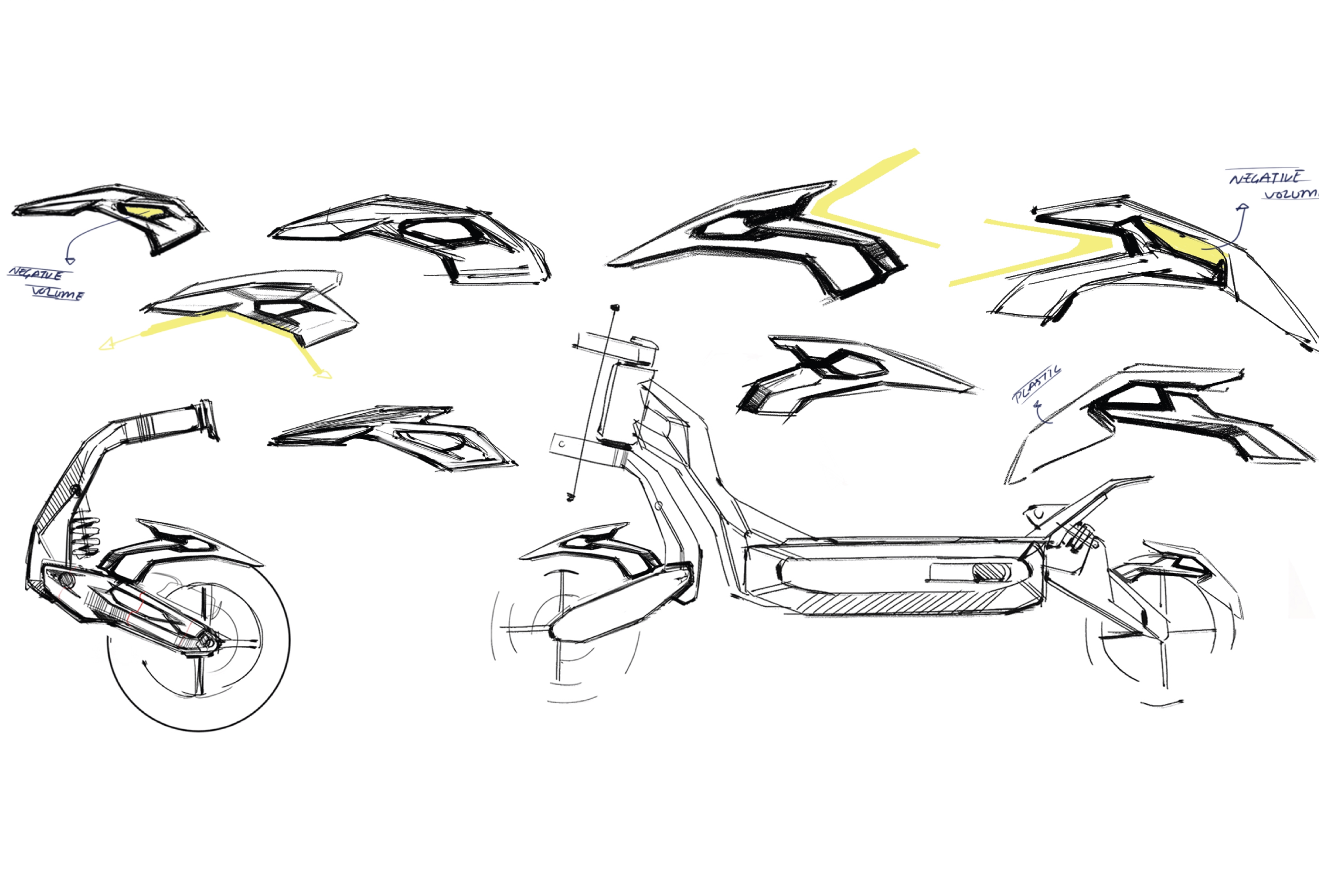Real talk: we didn’t design or manufacture this scooter. We partnered with a factory whose design team includes ex‑Polaris (ATV & golf carts) industrial designers. Our role was choosing the right partner, tuning the spec, and pushing for a fair price. No fluff, no complexities. Just receipts—and sketches.
TL;DR
-
Origin: Designed by our factory partner’s team (several designers previously worked on Polaris ATV & golf cart programs).
-
Approach: A remix of proven scooter ideas: the best bits from popular models blended into one platform.
-
Voro’s part: Spec curation, what do customers want, serviceability, parts pipeline, and price discipline.
This post is a visual timeline—early napkin lines to refined concept sheets—plus notes on what changed and why.
Credits & disclosure
-
Hooga Daytona design IP belongs to our manufacturing partner.
-
Designers include talent with past experience on Polaris programs. No affiliation or endorsement by Polaris.
-
VoroMotors handled spec selection, validation rides, feedback loops, spare‑parts strategy, and go‑to‑market.
(Polaris is a trademark of Polaris Inc. Mentioned here only to describe prior experience of individual designers.)
Why this design won
We benchmarked dozens of scooters, then asked the factory to remix: stability from long‑wheelbase cruisers, serviceability from modular decks, lighting from halo commuters, and a battery/controller layout that keeps the center of mass low. Result: a platform that feels familiar on day one and doesn’t punish you at the cash register.
The Sketchbook (gallery captions)
1) Silhouette explorations — stance & rake
What you’re seeing: Fast line studies testing wheelbase, deck drop, and head‑tube angle. Why it matters: Stability vs. agility tradeoffs start here. 
2) Frame spine & battery sled
What you’re seeing: Cross‑sections of a reinforced center spine with a serviceable battery bay. Why it matters: Low CG, easier pack swaps, cleaner wiring.

3) Swingarm iterations
What you’re seeing: Triangulated swingarm concepts to manage torsion under load. Why it matters: Rear‑end stiffness without adding a ton of weight.

4) Deck geometry & foot stance
What you’re seeing: Step‑in deck, heel clearance, and clamp positions. Why it matters: Comfort on longer rides and better control under braking.

5) Controller cooling & airflow
What you’re seeing: Passive finning and directed airflow paths. Why it matters: Keeps performance consistent on hot days.

6) Fenders & splash management
What you’re seeing: Coverage arcs, mud‑shedding edges. Why it matters: Real riders, real weather.

7) Fold & latch mechanism
What you’re seeing: Lever geometry and safety interlocks. Why it matters: Solid feel without finger‑pinch drama.


8) Colorways & surfacing
What you’re seeing: Panel breaks, paint vs. texture, brand zones. Why it matters: Easy to keep fresh with limited‑run colors.


Colorway naming has changed to Panda and Two Toned.

What changed from sketch to production
-
Throttle map & braking: smoothed low‑speed control; stronger, repeatable braking feel. a.k.a Reverse finger throttle.
-
Tires & wheels: spec’d rubber that balances grip and range at 13 inch compared to 11 inch initial product roadmap
-
Fasteners: corrosion‑resistant hardware on exposed areas.
-
Harness: cleaner loom with labeled quick‑disconnects for service.
The “remix” philosophy
Great products rarely reinvent physics; they re‑arrange the right ingredients. Daytona blends geometry you already trust, a battery/controller layout that stays cool and planted, and a parts ecosystem we can stock for years. Performance without drama. Price without games.
FAQ (straight answers)
Did Voro design the Hooga Daytona? No. The design is by our factory partner’s team (including ex‑Polaris designers). We selected key specifications, tuned it, validated it, and support it.
Is Polaris involved? No. Some designers previously worked on Polaris programs; that’s the extent of the connection.
Why call it a “remix”? Because it blends proven features from popular scooters into a single, coherent platform at a fair price.
What does Voro control? Spec, serviceability requirements, parts supply, documentation, and customer support.
Call to action
-
See the final product and the scooter up close: https://www.voromotors.com/products/hooga-daytona-72v-all-terrain-hyper-scooter
-
Watch the unboxing/livestream: https://www.youtube.com/live/qWRlSysxLe8?si=Nag6l4EDA3yAcr4Q
-
Ask us anything: Drop questions in the comments or our own reddit group —we’ll compile a follow‑up post.



